Author: Amanda Ahne
Asset Allocation Bi-Weekly – Reflections on Earnings (November 20, 2023)
by the Asset Allocation Committee | PDF
The third quarter’s earnings season is coming to a close and, once again, earnings beat expectations. In this report, we will take a more in-depth look at S&P 500 earnings and overall corporate earnings.
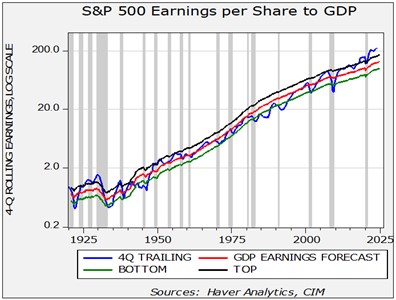
This chart examines S&P 500 earnings on a four-quarter trailing basis. We have regressed nominal GDP against earnings; the idea is that the red line on the chart should estimate the impact of economic growth on earnings. In other words, the red line reflects what part of earnings is explained by nominal GDP growth. The lines that bracket the red line represent a standard error from the forecast. One reason for owning stocks is to participate in the growth of the economy. When earnings are above the red line on the chart, it suggests margin expansion. There have been periods of outsized margin expansion. For example, from 1925 into 1929, earnings outpaced GDP by a wide margin. They also reached the upper line on a couple of occasions in the 1950s, but that level wasn’t reached again until 2007. It’s notable that once earnings recovered after the Great Financial Crisis, they then stayed elevated and even shrugged off the pandemic recession.
Why have earnings been so persistently strong? A likely reason is that firms have accumulated market power. That means firms don’t face competition and therefore have a greater ability to maintain profit margins. Often, these firms have monopsonistic or oligopsonistic power in the labor markets. When faced with rising input costs, firms can either depress labor costs through wage cuts or layoffs or pass on cost increases to consumers via higher prices. Unfortunately, there is no single variable that captures market power. However, observing the margins after GDP to the trend in CPI, the current environment does suggest market power.
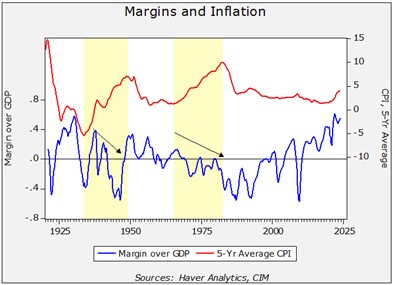
The periods shaded in yellow show when the trend in inflation is rising. The margin measure is the residual from S&P 500 earnings not accounted for by GDP. The fact that margins are holding up while facing rising prices does suggest that firms enjoy market power. As the chart shows, margins tended to weaken during periods when the trend in CPI was rising.
The impact of market power over labor is also evident.
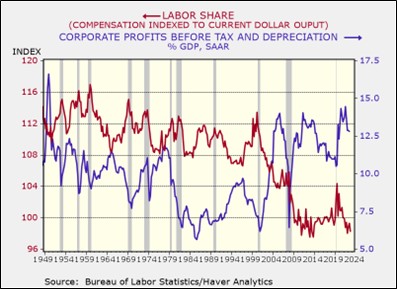
The above chart shows the labor share, which is defined as compensation relative to output. As the chart indicates, the labor share was mostly steady from 1949 into 2000. Although in this century, there was a definitive shift downward in the labor share. It has stabilized in the wake of the Great Financial Crisis, but it has not improved to its earlier levels.
This market power is likely due to three factors. First, globalization, which in its current form weds global markets with technology, has allowed firms to separate the design function away from production, giving firms the opportunity to source low-cost labor abroad. In the U.S., immigration-friendly policies tended to lift the labor supply. Second, anti-trust policy adopted the Bork Standard beginning in the mid-1980s. This legal theory postulated that if a company’s pricing policy didn’t adversely affect consumers, market combinations were not harmful. This policy led to larger firms that developed market power. Third, deregulation allowed for the rapid adoption of new technologies which lowered costs, but pricing power meant that these cost reductions would not necessarily be passed on to consumers.
The key question is whether this environment will persist. There is evidence to suggest that it won’t. First, globalization rests on a functioning hegemon providing global security and a reserve currency and asset. We have detailed in numerous Bi-Weekly Geopolitical Reports the ways in which America’s hegemony is under threat. As U.S. power wanes, conflicts become more common, leading to supply disruptions that tend to depress market power. Second, Lina Kahn, the head of the Federal Trade Commission (one of the bodies that approves mergers and acquisitions), is working to implement an earlier anti-trust standard which argues that size alone is an impediment to combinations. We doubt she will be initially successful, but now that the Bork Standard has been questioned, we expect the policy will erode over time, leading to greater competition. Finally, we anticipate that increased regulation, especially in terms of industrial policy (the government steering investment), trade impediments, and immigration restrictions will give labor power again. We are already seeing a wave of strikes that have had remarkable success, mostly due to the exit of baby boomers from the labor force. Over time, however, restricting immigration will play a role in boosting labor power.
Thus, we expect this period of remarkable profitability will end at some point. The trick is timing. It isn’t likely to happen immediately, but the conditions to reverse profitability are developing. These circumstances are something investors will need to monitor in the coming years. What should an investor expect to see as these margins narrow? Lower capitalization stocks, which don’t enjoy the benefits of market power to the same degree as larger firms, will probably outperform large caps.
Daily Comment (November 17, 2023)
by Patrick Fearon-Hernandez, CFA, and Thomas Wash
[Posted: 9:30 AM EST] | PDF
Good morning! Oil prices fell into bear market territory on Friday due to a jump in U.S. inventories and demand pessimism. In other news, Shohei Ohtani, formerly of the Angels, and the Braves’ Ronald Acuna Jr. were named the most valuable players in their respective leagues. Today’s Comment begins with our thoughts about holiday spending this year. We then discuss why governments are struggling to find ways to fund initiatives, and then detail Argentina’s run-off election to be held Sunday. As always, our report includes a summary of the latest domestic and international data releases.
Holiday Cheers? Major retailers are concerned that Christmas spending may slow this year.
- This week several major retailers reported higher profit margins with tighter inventory but lower revenue. The decline in sales mirrors the impact of rising prices on consumer spending. Walmart’s (WMT, $156.04) report further underscored this trend, indicating a “softening” and “uneven sales” pattern since October. Shares of the company stock plummeted 8% on Wednesday due to the pessimistic outlook. At the same time, Target (TGT, $129.94) indicated that it believes consumers are delaying purchases until the last minute, while Macy’s (M, $13.33) results demonstrated that consumers may be receptive to purchases if prices are reduced.
- Recent economic data provides some clues about how holiday spending might unfold. October retail receipts indicate a significant slowdown in consumer spending compared to its peak in 2021. When adjusted for inflation, the data shows a year-over-year decline of 0.73%. This decline is likely attributed to a confluence of factors, including rising prices and high-interest rates dampening consumer spending. The trend is expected to persist as more households resort to increasingly expensive credit cards to finance purchases. The data indicates that real spending has not yet declined significantly enough to raise major concerns about the economy, but time will tell whether this will hold up over the next few months.
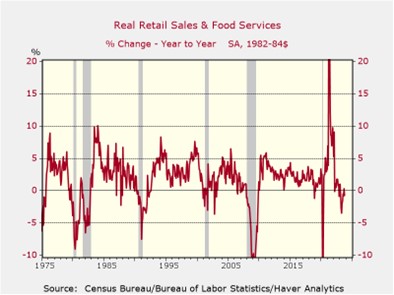
- The upcoming holiday season will serve as a critical test of consumer sentiment and spending patterns. Stronger-than-expected sales would provide reassurance that consumption remains resilient heading into 2024. Conversely, a weaker-than-expected performance would likely raise further concerns about the economy and could lead to more predictions of a downturn. In an effort to boost sales, firms may consider decreasing prices, which could offer a potential double benefit of stronger sales and lower inflation. However, it is important to acknowledge that price reductions may carry the risk of further cooling in the labor market. At this time, we remain optimistic that consumption will continue to be an engine of economic growth.
Fiscal Deficits: Governments are struggling to find a way to meet their spending plans without exacerbating their growing deficits.
- In the absence of a comprehensive spending bill, the Pentagon faces a potential $82 billion budget cut over the next two fiscal years. This mandate stems from a provision embedded in June’s debt limit legislation, which requires all federal departments and agencies to trim their budgets by 1% from 2023 levels for the subsequent two fiscal periods if no funding agreement is reached before the new year. The potential budget cut could hamper Washington’s efforts to bolster its presence and influence in the Indo-Pacific region, where it seeks to counter China’s growing dominance.
- Similarly, Germany’s top court has struck down a plan to fund climate change initiatives using off-budget funds, jeopardizing about 770 billion euros ($837 billion) in spending plans. The ruling, which comes as a blow to the country’s three-party coalition government, means that the government will have to find alternative ways to finance its ambitious climate goals. While the government has vowed to find a solution, there will likely be some bickering among members of the coalition. German Finance Minister Christian Lindner has said that it is possible to fund the budget without using additional debt or raising taxes; however, the climate fund has been frozen in the meantime.
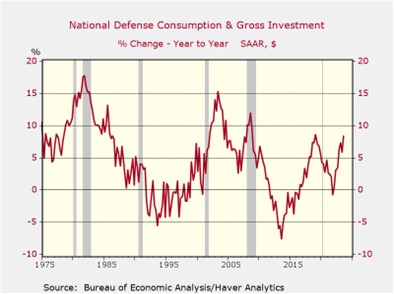
- The pandemic’s burden on government finances, coupled with escalating geopolitical tensions, will necessitate further defense spending while potentially curtailing other initiatives. Climate change initiatives face heightened scrutiny as households hesitate to embrace costly transitions to a low-carbon economy. Governments are unlikely to completely abandon their commitment to climate change mitigation, but they may be forced to postpone some deadlines in the face of budgetary constraints. Defense spending is likely to remain strong as there appears to be a consensus that the world is becoming a more dangerous place. Hence, we do not view the budget tightening as a potential threat to portfolio positions within Aerospace and Defense.
Where Will Argentina Swing? Investors will be closely watching the Argentine elections on Sunday to gauge the political climate in South America.
- The two candidates represent opposing ends of the political spectrum, with Javier Milei’s campaign drawing comparisons to former U.S. President Donald Trump and former Brazilian President Jair Bolsonaro due to his skepticism of central banks and his focus on law and order. Conversely, his opponent, Sergio Massa, despite being considered “the least Peronist of the Peronists,” has emphasized his party’s legacy of welfare spending and subsidies and is expected to seek support from radical leftists. The outcome is considered close, but Massa is favored to win given his strong performance in the general election.
- Geopolitical considerations also loom over this election, as China seeks to strengthen ties with Argentina to safeguard its access to the country’s resources. Last month, the People’s Bank of China extended a $6.5 billion currency swap line to Argentina, enabling Buenos Aires to intervene in currency markets and settle imports in yuan (CNY) rather than dollars, which will prevent it from falling into arears with the International Monetary Fund. This move was widely perceived as a political favor for Sergio Massa, the current finance minister, as he seeks to convince voters of his ability to steer the country away from the brink of collapse.
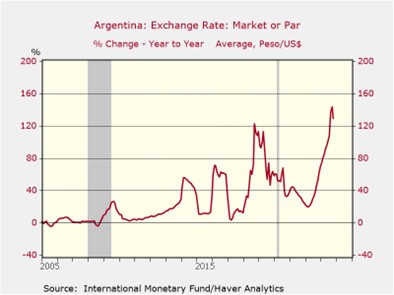
- The outcome of the election will shape the trajectory of a country grappling with persistently high inflation and an ever-growing debt burden. A Massa victory is likely to be favored by markets, as he is expected to pursue more conventional economic policies than his opponent. Conversely, a Milei win could potentially align with U.S. efforts to maintain regional influence, as he has shown that he is less willing to cooperate with China. Although the election may not have major impact on markets, it may provide further signs as to how the world is breaking into geopolitical blocs as the world moves away from globalization and towards regionalization.
Other News: Iran maintains that it does not want the Israel and Hamas conflict to spread but has warned that it may take action if the assault on Gaza continues. The message is a positive sign that there is a communication between Washington and Tehran, which should reduce the chance of miscalculation. Spanish Prime Minister Pedro Sánchez won another term after securing an amnesty deal with the Catalan separatists. It is unclear how long he will be able to maintain his coalition as there has been public outcry following the appeasement of the separatists. Powell’s firm grip on the Fed is further evidenced by his exceptionally low dissent rate. Our analysis reveals that Powell has had the fewest dissents per meeting of any Fed chair since Thomas B. McCabe.
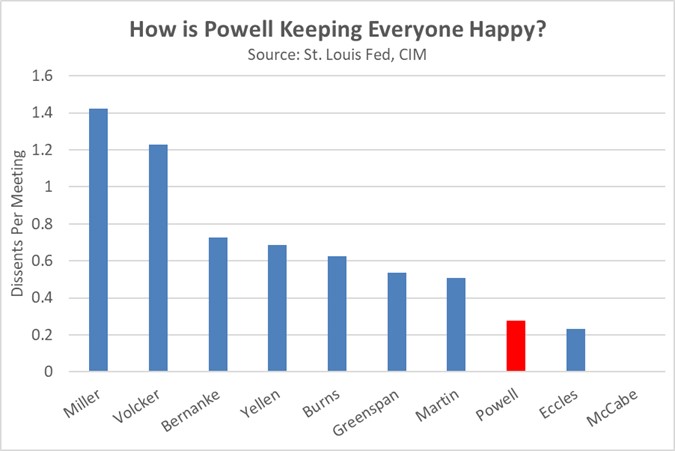
Daily Comment (November 16, 2023)
by Patrick Fearon-Hernandez, CFA, and Thomas Wash
[Posted: 9:30 AM EST] | PDF
Good morning! Gold prices are rising as investors eagerly await the Federal Reserve’s next policy decision, while Gerrit Cole has been named the American League Cy Young Award winner. Today’s Comment delves into the reasons behind the surge in investor risk taking being fueled by optimism over a possible end to interest rate hikes, the potential easing of commodity inflation next year, and Xi Jinping’s softening stance towards certain adversaries. As always, our comprehensive report summarizes the latest domestic and international data releases.
Monetary Inflection Point? Risk appetite has started to pick up as investors are growing confident that monetary tightening is over.
- Recent economic data suggests that central banks are making progress towards their inflation targets. The Bureau of Labor Statistics (BLS) released data earlier this week showing that producer prices (PPI) rose 1.4% since October 2022, while consumer prices (CPI) increased 3.2% in the same period. This trend is also evident in other countries, with the eurozone and the U.K. both making headway toward achieving their respective 2% inflation targets. While policymakers have not ruled out further rate hikes, fed funds futures contracts indicate a 97.3% probability that the central bank will hold rates steady at its next meeting and an 81% likelihood of a rate cut by June 2024.
- Expectations of a Fed pivot have led investors to diversify away from safe assets. The Bloomberg indexes for global bond and dollar performances have also reflected the recent shift in risk sentiment. The investment-grade debt index from a multitude of countries has surged 3.1% in the past two weeks, recouping half of the losses it had incurred since mid-July. This impressive rally aligns with the Bloomberg Dollar Index, which indicates a similar resurgence of global currencies against the greenback within the same period. While this market response to economic data is encouraging, some investors remain cautious, recognizing that underlying uncertainties may reverse the present trend.
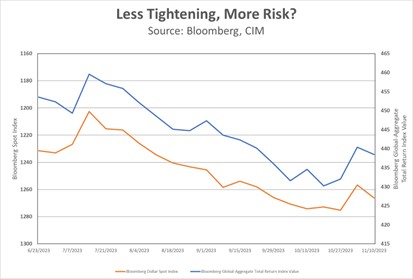
- In the near term, this shift might provide some respite for investors who have endured losses in riskier assets earlier this year. Notably, the weakening U.S. dollar should uplift emerging market equities. However, the sustainability of this trend remains uncertain. Much of the performance of the dollar and risk assets has been driven by expectations of central banks halting their tightening cycle, which may or may not materialize. Nevertheless, investors should also be mindful that as monetary policy concerns recede, attention may shift back to GDP growth, which could favor U.S.-denominated assets due to the country’s robust economic outlook.
Commodity Price Pressures: Increased supply and weakening demand are expected to put downward pressure on food and other commodity prices going into 2024.
- Global food prices are expected to fall next year, according to agribusiness lender Rabobank’s annual outlook. A key factor driving this downward trend is the surge in production resulting from firms seeking to capitalize on higher prices. Prices for sugar, coffee, corn, and soybeans are all expected to be impacted by the projected increase in supply. Conversely, China’s anticipated growth in copper output is likely to keep metal prices below 2022 levels in 2024. S&P Global Market Intelligence expects the London Metal Exchange’s three-month price per metric ton to hit $8602 in 2024, below its $8784 from two years prior and roughly in line with this year’s estimated price of $8596. However, copper prices are expected to spike in 2025 and onwards.
- On the demand side, there are also indications that commodity prices may face resistance. Rabobank forecasts that slower economic growth due to higher interest rates and elevated prices could dampen demand. Several major economies are already teetering on the brink of recession. The German economy is projected to contract by 0.3% in 2023. Meanwhile, China’s economic woes are expected to persist into the following year. The lack of growth across the globe could make it more challenging for commodities to sustain their current price levels.
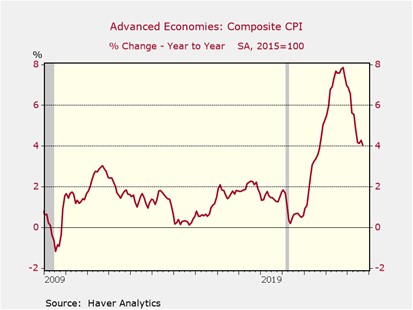
- The moderation in commodity prices offers a glimmer of hope amidst the looming threat of a global economic downturn. The anticipated easing of food inflation should provide a much-needed boost for emerging markets, where high food prices have historically been linked to social unrest. Moreover, the relaxation of commodity pressures is likely to contribute to global efforts to curb inflation. If these supply and demand dynamics persist, the improvement in commodity prices could facilitate economic growth for non-commodity producers, even in the face of a potential recession.
Xi’s Delicate Dance: The Chinese president faces difficulties in fostering cordial relations with his Indo-Pacific rivals.
- President Biden’s seemingly impromptu remark calling Xi Jinping a “dictator” during a post-meeting Q&A session likely altered the tone of their discussions. Prior to this comment, the two leaders had reportedly engaged in productive talks, agreeing to collaborate on combating fentanyl trafficking and reestablishing military communication channels. Following his meeting with Biden, Xi is expected to meet with Japanese Prime Minister Fumio Kishida on Thursday. The two will likely discuss the recent detaining of well-known Japanese businessman Hiroshi Nishiyama on suspicion of espionage. His imprisonment has raised concerns about China’s recent crackdowns on foreign workers.
- Xi Jinping’s recent efforts to cultivate stronger ties with the international community underscore his determination to revitalize China’s economy, which has encountered hurdles following its stringent pandemic lockdowns. While investment spending has traditionally been a cornerstone of China’s growth, its aversion to accumulating debt necessitates a diversification of growth strategies. Trade emerges as an appealing option as it would allow the country to preserve its manufacturing base while alleviating deflationary concerns. In October, headline CPI dipped 0.1% year-over-year, while core CPI increased by 0.7%. A possible reset in relations with China and its rivals may help lead to an increase in its net exports which have been a drag on growth.
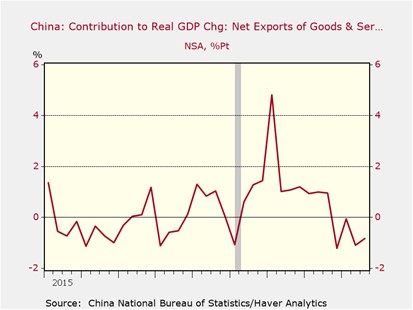
- Xi’s recent overture should not be misinterpreted as a change of heart. He has offered no indication that he is prepared to retract his willingness to decouple from the U.S. or remove his country’s backing of Russia. Therefore, the thaw in intentions is likely a tacit acknowledgment that he does not desire an abrupt end to relations with the world’s largest economy. However, this does imply that he may be more focused on addressing domestic challenges rather than settling historical scores such as the reunification of Taiwan, suggesting that the risk of conflict between the two largest economies may be diminishing.
Other News: West Virginia Senator Joe Manchin announced that he is contemplating a presidential bid. His inclusion adds another layer of complexity to an already crowded field, further clouding the outlook for the 2024 election. The GM-UAW contract is expected to be approved, thus reducing the chance of another strike. The Senate approved the stopgap spending bill to keep the government funded into 2024. This sets up another fight in two months but should calm nerves about disruption to governmental operations.
Weekly Energy Update (November 16, 2023)
by Bill O’Grady, Thomas Wash, and Patrick Fearon-Hernandez, CFA | PDF
Crude oil prices have retreated from their early October highs.
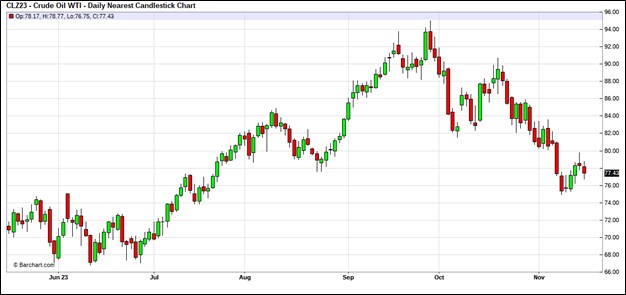 (Source: Barchart.com)
(Source: Barchart.com)
Commercial crude oil inventories rose 0.8 mb compared to forecasts of a 2.0 mb build. The SPR was unchanged, which puts the net build at 0.8 mb.
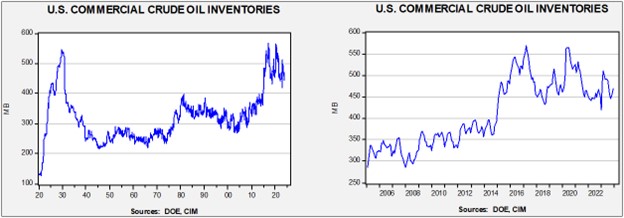
In the details, U.S. crude oil production was steady at 13.2 mbpd. Exports rose 0.4 mbpd, while imports were unchanged. Refining activity rose 0.9% to 86.1% of capacity. Refinery activity has started its seasonal recovery which should last into December.
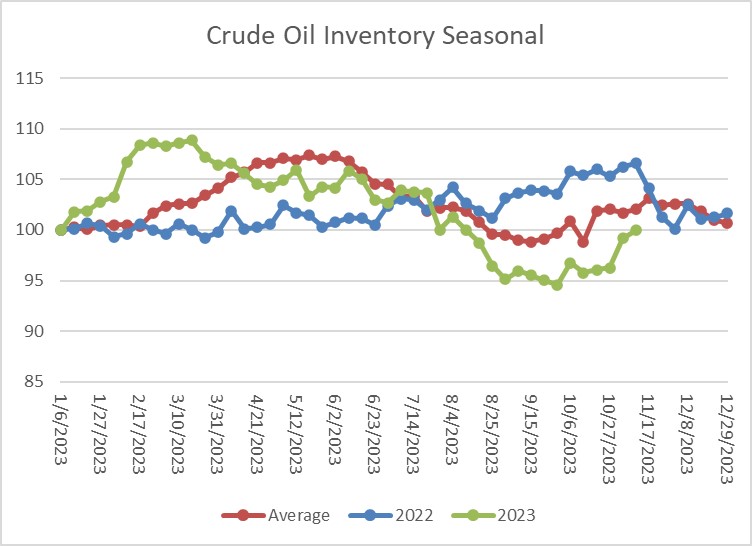 (Sources: DOE, CIM)
(Sources: DOE, CIM)
The above chart shows the seasonal pattern for crude oil inventories. We continue to see lower-than-normal inventory accumulation although the gap to average is narrowing.
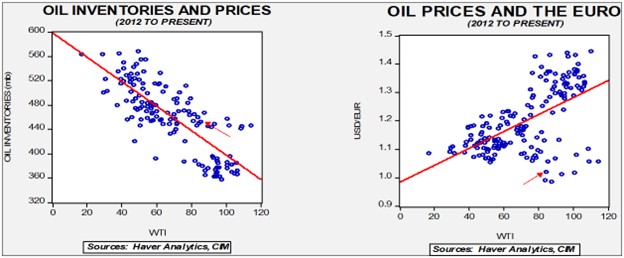
Fair value, using commercial inventories and the EUR for independent variables, yields a price of $67.53. However, given the level of geopolitical risk in the market, we are not surprised that oil prices are well above this model’s fair value.
Since the SPR is being used, to some extent, as a buffer stock, we have constructed oil inventory charts incorporating both the SPR and commercial inventories.
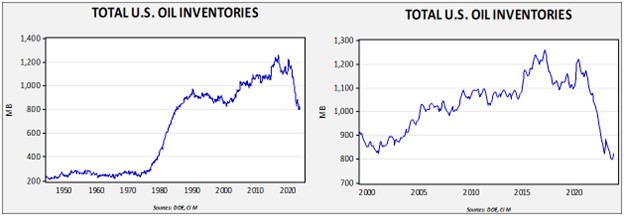
Total stockpiles peaked in 2017 and are now at levels last seen in late 1984. Using total stocks since 2015, fair value is $91.44.
Market News:
- The IEA released its November oil market report, covering the month of October. Rising U.S. and Brazilian oil production lifted global production to 102.0 mbpd. Demand is also expected to be 102.0 mbpd, meaning that inventory accumulation will remain modest. Demand next year is expected to rise to a modest 0.9 mbpd. The IEA estimates that OPEC+ has 5.1 mbpd of spare capacity of which the Kingdom of Saudi Arabia (KSA) has 3.2 mbpd.
- Forecasts from the EIA indicate that the Permian Basin will continue to show production growth, but overall shale production is expected to decline.
- As world leaders prepare for COP28, we see a divergence between promises and behaviors. Despite promises of reduced carbon emissions, nations around the world continue to expand fossil fuel production. This is a classic example of the “free rider” problem, which states that an individual benefits from good but costly behavior, but benefits more from other’s good but costly behavior. And so, no one does anything, but expects others to “do good.” Without an enforcement mechanism, carbon reduction is just talk.
- This year is shaping up to be one of the warmest on record, with October shattering records. The overall upward trend in temperatures is being bolstered by the sunspot cycle, El Niño, and an undersea volcanic eruption earlier this year. If this warmth continues, it will be bearish news for natural gas, propane, and heating oil.
- Environmentalists are targeting the U.S. LNG industry on the grounds of excessive methane emissions. Methane often leaks from natural gas wells and is a potent greenhouse gas. However, if these activists are successful, it puts European energy security at risk.
Geopolitical News:
- Hamas has confirmed that it attacked Israel on fears that its interests were being ignored. The Saudi talks to normalize relations with Israel heightened worries that the Palestinian cause was being forgotten. Despite the attacks, there are reports that the KSA is still interested in continuing talks with Israel.
- Although the markets are acting as if the threat of regionalization has ended, in reality, the risk remains. Iranian proxies have been attacking U.S. bases in the region and the American miliary has responded.
- The Houthis have shot down a U.S. MQ-9 Reaper drone that was said to be over international waters.
- CIA Chief Burns has visited Qatar to try and keep the conflict in Gaza contained.
- Oil executives note that geopolitical risks are intensifying quickly. The acknowledgement of new risks will change the behavior of firms. We could see less interest for projects located in geopolitically risky areas, and a desire to hold more inventory may develop. The recognition of a new risk environment is a significant change.
- ExxonMobil (XOM, $104.85) has agreed to exit the West Qurna 1 oil field project in Iraq with PetroChina (601857, CNY, 7.14) agreeing to be the replacement.
- India has reduced its oil import costs by purchasing Russian crude oil.
- As Russia has almost completely ended piped natural gas exports to Europe, it is trying to sell its excess supply in the LNG market. The U.S. is moving to prevent that from happening by sanctioning buyers of LNG from Russia’s Arctic LNG2 project. North America is rapidly building out LNG capacity.
- Meanwhile, nearly all Russian oil sales are currently above the $60 per barrel cap. Creating a “ghost fleet” of tankers and buyers willing to accept shipments without Western insurance has been the key to avoiding the cap. The U.S. is trying to increase compliance efforts, but these efforts have not tightened supplies so far. Denmark is considering steps that would prevent Russian oil tankers from exiting the Danish straits.
Alternative Energy/Policy News:
- A key element of the energy transition is electrification, which requires copper. We saw the U.S. kill a proposed copper project in Alaska earlier this year, and now Panama has seen protests against another project. Although we understand that local interests need to be considered due to the disruption caused by mining, it is unclear where the copper will come from to meet the demands of the energy transition.
- At the same time, currently weak prices for copper, reflecting a slowing global economy, is dampening enthusiasm for mining investment.
- ExxonMobil plans to open a lithium project in Arkansas in 2027; the company appears to be hedging its oil and gas business.
- China’s dominance in rare earths is well known. Automakers are looking to use less of these metals to reduce China’s influence.
- A new climate report suggests that climate effects are having sizable financial consequences as well. The costs of addressing storms in the U.S. is leading to increases in insurance costs.
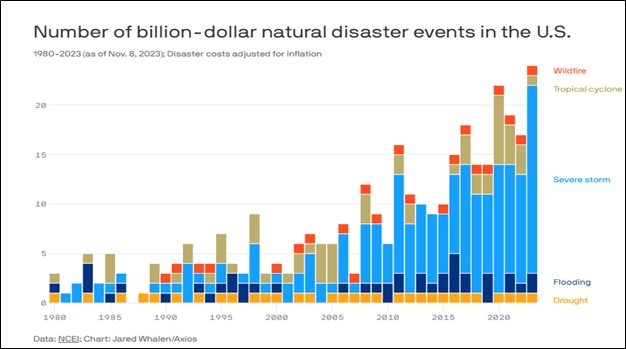
- A township board in Michigan has been recalled after it approved tax incentives for a Chinese car battery installation.
- EV sales in the U.S. are slowing, so automakers are increasing discounts to lure buyers. High costs and range anxiety are hurting sales. Research suggests that EVs have fewer miles driven compared to gasoline vehicles, suggesting that EV owners are using the vehicles as “town cars” while still using gasoline cars for distance driving.
- The Utah Associated Municipal Power Systems, an agency representing 50-community owned utilities, canceled a small nuclear modular reactor purchase, citing cost overruns. Small modular nuclear reactors hold the promise of lowering costs because the units are scalable; however, the first one won’t be. The idea still has promise, but what this shows is that it will take a strong financial commitment for this concept to work.
- On the positive side, a new facility will be able to produce high-assay, low-enriched uranium on U.S. soil for the first time. Up until now, the U.S. had been getting this fuel from Russia. The ability to produce this fuel will allow the U.S. to build out advanced nuclear reactors and complete much of the fuel cycle.
- China currently controls about 80% of solar module production capacity. This dominance likely means that nations much either buy from China or pay high prices for domestically produced panels. China appears to be deploying export promotion to support its slow economy, which could lead to gluts in other alternative energy products.
Rapidly rising costs for wind turbines are leading to cancelled projects or attempts to renegotiate prices. If governments don’t get involved, wind projects may stall. Parts companies for windmills indicate that wind goals set for 2030 will not be met.
Note: Due to the Thanksgiving Day holiday, the next report will be issued November 30.
Daily Comment (November 15, 2023)
by Patrick Fearon-Hernandez, CFA, and Thomas Wash
[Posted: 9:30 AM EST] | PDF
Our Comment today opens with new impediments to U.S. investments in China. We next review a wide range of other international and U.S. developments with the potential to affect the financial markets today, including the latest on the Israel-Hamas conflict, new signs of economic weakness and falling inflation pressure in Europe, and House passage of a new stopgap funding bill for the U.S. government.
United States-China: The U.S.-China Economic and Security Review Commission, an advisory panel on China policy, issued a recommendation yesterday that Congress pass a law forcing U.S. publicly traded companies to disclose how their investors are exposed to risks related to China. For example, the commissioners recommended that the companies disclose the percentage of their total assets in China, their joint ventures with Chinese firms, the amount and nature of research and development they undertake in China, and the influence of any employee associated with the Chinese Communist Party in corporate decision-making.
- If passed, the disclosure requirement would be yet another impediment to U.S.-China capital flows.
- Separately, the Federal Retirement Thrift Investment Board, which oversees approximately $771 billion of retirement savings for federal workers, said today that it will change the benchmark index for its international fund to avoid exposure to stocks listed in China or Hong Kong, citing increased U.S.-China geopolitical tensions.
- Finally, we note that President Biden and President Xi plan to meet for four hours today at the Asia-Pacific Economic Cooperation summit in San Francisco. At the end of the meeting, Biden and Xi are expected to announce a number of smaller-scale agreements. More broadly, the summit may help slow the current downward spiral in U.S.-China relations.
Taiwan: The country’s top two opposition parties, the China-friendly Kuomintang and the Taiwan People’s Party, have struck a deal to field a joint ticket in January’s presidential election. The deal aims to help the opposition compete better against Vice President Lai Ching-te, the leading candidate of the ruling Democratic Progressive Party, which has forged tighter ties with the U.S. and is currently leading in the polls.
Israel-Hamas Conflict: Hours after the U.S. officially backed Israeli assertions that the Hamas government in Gaza places military command posts in hospitals, the Israel Defense Forces said they launched a targeted strike against Hamas personnel in the territory’s besieged Al-Shifa Hospital. The IDF says the raid turned up weapons and other “concrete evidence” that the facility was being used as a Hamas command post. The IDF says that evidence will be shared publicly in the near future.
- Meanwhile, Hamas authorities say Israel’s airstrikes and other attacks on Gaza during the conflict have now killed about 11,000 people, many of them noncombatant women and children. If that figure is accurate at all, it is certainly brutal and horrifying, and it reflects an apparent policy decision by the Israeli government to defang Hamas no matter what the cost to civilians or to Israel’s own reputation and political support.
- Still, given that Gaza had a population of about 2.0 million at the start of the conflict, 11,000 dead (and perhaps tens of thousands injured) seems low enough to suggest that the IDF really is taking some care to avoid hurting civilians. Besides, other reports suggest that up to 50% of all the structures in Gaza have been destroyed or severely damaged by Israel’s attacks. If that translates to 11,000 structures hit, it suggests “only” one death and perhaps several other injuries for each structure targeted.
European Union: In a new sign that the European economy is failing to keep up with activity in the U.S., the European Commission today cut its 2023 growth forecasts for both the broad EU and the eurozone. In each region, the commission now forecasts that gross domestic product this year will expand just 0.6%, compared with a forecast of 0.8% in September. The faltering growth reflects a range of problems, from high inflation and interest rates to weaker global demand for European exports.
United Kingdom: In another sign that inflation pressures are easing worldwide, the U.K.’s October consumer price index was up just 4.6% from the same month one year earlier, less than expected and much less than the 6.7% increase in the year to September. Excluding food, energy, and other volatile categories, the October core CPI was up an annual 5.7%, versus 6.1% in the year to September. Signs of cooling inflation have boosted hopes that the Bank of England can forego further interest-rate hikes and may even start to cut rates in 2024.
Russia-Ukraine War: The Ukrainian government has struck a deal with major insurers to provide war-risk coverage for ships carrying grain and other foodstuffs out of Ukrainian ports. After Russia withdrew from a safe-passage deal with Ukraine over the summer, Kyiv has managed to get several ships moving out of its ports, but the new deal could further boost the country’s agricultural shipments, bolstering global supplies and helping hold down prices.
- Separately, EU officials are looking for new ways to clamp down on Russian oil revenues following recent reports that Moscow is largely circumventing the West’s $60-per-barrel cap on its exports.
- One proposal would have Denmark stop, inspect, and potentially impound tankers carrying Russian oil through Danish waters without Western insurance, under laws permitting states to check vessels they fear pose environmental threats.
- If implemented, the plan would naturally be high risk, potentially producing serious naval tensions in the Baltic region.
U.S. Fiscal Policy: The House of Representatives yesterday passed Speaker Johnson’s two-step stopgap funding measure to keep some federal departments operating until mid-January and others until early February. Since many of Johnson’s own Republican Party voted against the bill because it lacked spending cuts and other positions favored by the far right, passage of the measure required the votes of many Democrats.
- The “continuing resolution” now moves to the Senate, where prospects appear to be good that it will pass and be sent to President Biden to be signed into law.
- Nevertheless, even if the bill passes and averts a partial government shutdown this weekend, there will still be the chance of a fresh impasse and potential shutdown when the new bill expires early in 2024.
U.S. Labor Market: Despite the national sigh of relief when the United Auto Workers and the major U.S. automakers struck a tentative deal on a new labor contract, workers at several plants run by General Motors (GM, $28.20) have voted to reject the deal. That puts the GM tally to date at about 50%, with voting set to continue for another week or two. In contrast, the proposed deals at Ford (F, $9.86) and Stellantis (STLA, $20.25) are on track to be approved by comfortable margins. The neck-and-neck voting at GM is a further reflection of just how empowered workers feel in the midst of today’s labor shortages.
U.S. Consumer Price Inflation: In the interest of acknowledging contrarian viewpoints, we note that the Wall Street Journal today carries an interview with Cathy Wood, the founder of ARK Investment Management and a major technology-stock cheerleader, in which she argues that new technologies and falling commodity prices will lead to a future of deflation rather than inflation. Of course, this could simply be an instance of Wood “talking her book,” since lower inflation implies lower interest rates and higher valuations for long-duration stocks like technology start-ups. We continue to believe that consumer price inflation in the coming decades will be higher and more volatile than in the post-Cold War period of relative peace and globalization over the last three decades.
- It’s difficult to forecast inflation rates over such a long period, but we would not be surprised if they average between 3.0% and 4.0% between now and mid-century, versus the average of 2.5% over the last 30 years (see chart below).
- While technology advancements will help bring down some costs, we think that will be offset by factors such as:
- The global economy’s fracturing into relatively separate blocs;
- The shift to less efficient global supply chains;
- The relocation of production back to relatively expensive countries in the West;
- Increased corporate and government investment spending to support those shifts;
- Higher commodity prices because of recent under-investment and the expected weaponization of supplies by the China/Russia bloc;
- Population aging and its associated labor shortages; and
- Potential increases in consumer spending as lower-skilled workers gain a bigger part of national income.
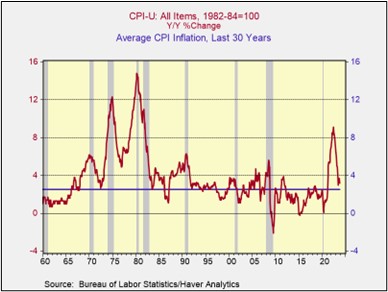
U.S. Financial Markets: After driving stock and bond prices sharply higher yesterday, the euphoria over yesterday’s report of falling inflation as measured by the consumer price index appears set to continue today. After the S&P 500 stock price index surged 1.7% yesterday, it and all the other main U.S. equity indexes are pointing to a higher open at the moment. Precious metals are also a bit firmer today, but longer-maturity bonds have given back some of yesterday’s rally, pushing yields up modestly so far this morning.
Daily Comment (November 14, 2023)
by Patrick Fearon-Hernandez, CFA, and Thomas Wash
[Posted: 9:30 AM EST] | PDF
Our Comment today opens with new data suggesting Russia is now almost completely getting around the West’s $60 price cap on its oil exports, potentially setting up new Western efforts to clamp down. We next review a wide range of other international and U.S. developments with the potential to affect the financial markets today, including a slowdown in British wage growth that could help ease consumer price inflation in the U.K. and the latest on efforts in the U.S. Congress to avoid a partial shutdown of the federal government, which could begin this weekend.
Global Oil Supplies: New analysis shows virtually all of Russia’s seaborne oil exports are now selling for more than the $60-per-barrel cap that Western nations have tried to enforce as a way to limit Russian revenues for its invasion of Ukraine. The Group of Seven countries and Australia had some initial success when they tried to enforce the cap by banning insurance and other services for shipments priced above $60 per barrel, but now it appears the Russians have learned to circumvent the ban with tactics such as buying up and using old tankers without Western insurance and falsifying price certifications.
- It should be no surprise that the $60 cap has been circumvented. From time immemorial, government efforts to control trade have been undermined by smugglers and sanctions busters.
- Nevertheless, the West’s restrictions on trade have probably imposed additional costs on Russian oil exports. Even if the oil is sold at prices above $60, the profitability of that oil and the revenues it provides to the Kremlin have probably been reduced.
- In any case, the wide circumvention of the ban has prompted Western officials to start discussing ways to tighten the cap. If such tightening happens, it could potentially reduce global oil supplies and help buoy energy prices.
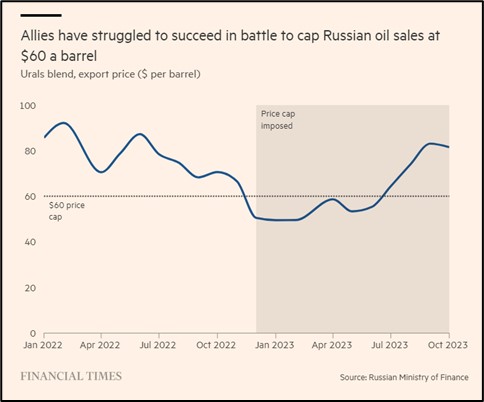
China-Taiwan: The Central Election Commission of Taiwan has certified the independent candidacy of Terry Gou, the founder of Foxconn (HNHPF, $5.93), for the presidential election coming up on January 13. Although Gou is currently trailing the three main candidates in opinion polls, Beijing is concerned that he will drain support from its preferred candidate, the Kuomintang Party’s Hou Yu-ih.
- The Chinese government has recently opened a large-scale investigation into Foxconn’s tax and land-use practices in China, in a move that has been widely interpreted as an effort to pressure Gou to drop out of the race. Company officials say they are bracing for additional such measures from China.
- Foxconn is best known as a supplier to Apple (AAPL, $184.80), and it is the key assembler of the company’s flagship iPhone. Additional Chinese pressure on Foxconn to force Gou out of the Taiwanese race could therefore potentially have an impact on Apple.
United States-Asia-China: After launching its Indo-Pacific Economic Forum last year to promote trade between the U.S. and the rest of the region and to loosen countries’ economic ties to China, the Biden administration has unexpectedly withdrawn its support for IPEF measures designed to ease cross-border data flows and coordinate labor standards. The retreat on free data flows apparently stemmed from administration efforts to tighten regulations over U.S. technology firms, while the retreat from labor standards came at the request of at least one U.S. lawmaker facing a tough election.
- Because of domestic political opposition, the U.S. is currently precluded from offering traditional tariff cuts and reduced import barriers to tease Indo-Pacific countries away from China’s economic pull. The administration, therefore, hoped that IPEF’s non-tariff measures would be attractive enough.
- Without the promise of free data flows and common labor standards, the IPEF deal will lean heavily on less attractive features, such as initiatives related to supply chains, clean energy, anti-corruption measures, and taxation.
- Perhaps most significant, the pullback from free data flows suggests the U.S. may soon adopt Chinese-style restrictions on data transfers. If so, it’s a sign that the fracturing of the world into relatively separate geopolitical and economic blocs, which we’ve been writing about so much, will disrupt not only trade, capital, and technology flows between the U.S. bloc and the China/Russia bloc, but it will also disrupt data flows.
United States-China Travel: New research by the Institute for International Education shows the number of U.S. citizens studying in China fell from more than 11,000 in the 2018-2019 academic year to just 211 in 2021-2022. The figures suggest many U.S. students have been put off by the Chinese government’s draconian pandemic shutdowns and aggressive law enforcement actions. Although the number of Chinese students in the U.S. remains about 290,000, the study illustrates how global fracturing is disrupting human travel and migration, just as it’s disrupting inter-bloc trade, capital, technology, and data flows.
United States-China Summit: When President Biden and General Secretary Xi meet tomorrow at the Asia-Pacific Economic Cooperation summit in San Francisco, they will reportedly announce a deal under which China will clamp down on companies exporting the precursor chemicals for fentanyl, the synthetic opioid that has spread addiction and death throughout the U.S. They are also expected to announce a deal to reopen military communication channels that Beijing shut after then-U.S. House Speaker Pelosi visited Taiwan in August 2022.
European Union: Recent data indicates the EU’s labor market is softening much more dramatically than the U.S.’s, especially in the industrial powerhouse of Germany and other northern countries. Much of the problem can be traced to weakening demand overseas and high energy costs. Higher unemployment will likely impose new fiscal burdens on EU governments but could also weaken inflation pressures, discourage further interest-rate hikes, and hold down the value of the euro.
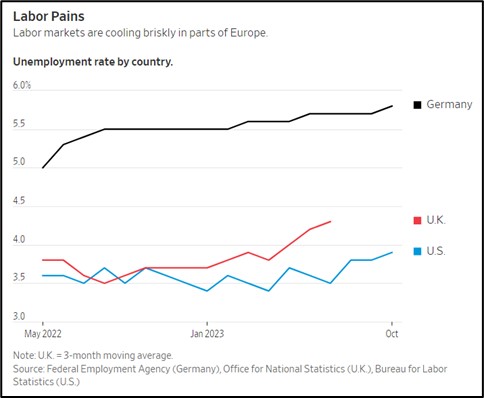
United Kingdom: Average wages in July through September, excluding bonuses, were up 7.7% from the same period one year earlier, marking a modest deceleration from the year-over-year increase of 7.9% in May through July. Total pay was up 7.9% on the year, versus 8.5% in the prior period. The figures point to a modest cooling in wage pressures, which could help bring down consumer price inflation in the U.K. and allow the Bank of England to hold off on further interest-rate hikes.
U.S. Fiscal Policy: In the House of Representatives, at least half a dozen Republican lawmakers have come out against Speaker Johnson’s proposed two-part stopgap funding bill, which aims to avoid a partial government shutdown when the current stopgap expires on Friday. Since the Republicans only control 221 seats in the chamber, while the Democrats have 213, the defections from Johnson’s own party mean his measure would likely need the support of at least some Democrats to advance the bill to the Senate, where its prospects seem better. At this point, prospects for a partial government shutdown this weekend appear to be too close to call.
U.S. Labor Market: Industry groups say the demand for seasonal workers during the upcoming holidays will be much cooler than in recent years, with public advertisements for such workers at the lowest level in a decade and hiring intentions down about 40% from their recent high in 2021. Individual companies are also reporting relatively modest hiring plans. Weaker demand for seasonal workers suggests the overall labor market is softening, which is likely to contribute to slower wage growth and weaker economic growth.
Bi-Weekly Geopolitical Podcast – #38 “The Archetypes of American Foreign Policy: A Reprise” (Posted 11/13/23)
Bi-Weekly Geopolitical Report – The Archetypes of American Foreign Policy: A Reprise (November 13, 2023)
Bill O’Grady | PDF
A critical issue in 2024 will be the U.S. presidential elections. America is going through a particularly partisan period where passing legislation is difficult and policy shifts between administrations are widening. Foreign policy isn’t exempt from these changes. In preparation for next year’s election, we wanted to update one of our earlier reports on the archetypes of American foreign policy.
In this report, we will briefly describe and discuss the four archetypes of American foreign policy. With presidential elections roughly one year away, we hope that this discussion will assist readers in examining the candidates and their potential foreign policy positions, using these archetypes as a guide. After we have laid out the archetypes, we will offer a short history of foreign policy from the end of WWII into the present and discuss how it has evolved from the Cold War into the post-Cold War period. We will conclude with reflections and market ramifications.
Note: Due to the upcoming Thanksgiving holiday, the next report will be our 2024 Geopolitical Outlook published on December 11.


